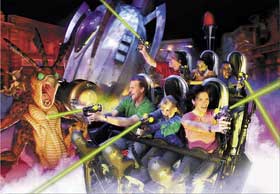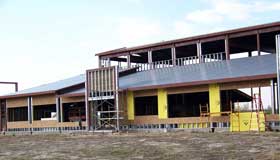
Vol. VII, No. 6, November-December 2007
- Editor's corner
- The changing nature of leisure time
- Who has time to wait?
- Online karting arrives
- Foundations Entertainment University registration is open
- Road kill stew
- Review of IAAPA show in Orlando, Florida
- Grandparent spending
- Free white papers for e-mail marketing
- Death to the black box, hello daylight
- Hurray for pizza
- The relationship of education to income
- Get real, this is a place for children?
- Update on uWink
Death to the black box, hello daylight
A prevailing myths of the location-based entertainment industry is that the traditional black box - the bleak, windowless facility - is the design concept that spells success. Unless your customers are bats, this concept couldn't be more wrong. Find out how daylight harvesting not only makes sense, but also makes cents, for today's LBEs.
The location-based entertainment (LBE) industry is truly amazing in many respects. We continue to be fascinated with how it continues to perpetuate myths about how to design facilities. One of those myths that hinders the performance of many facilities is the black box, the concept that the entertainment experience needs to be presented in a windowless black box, and a dark one, at that.
 This myth or design paradigm probably dates to LBE predecessors, including theaters, cinemas and many indoor experiences at theme parks, such as the current Men in Black Alien Attack at Universal Studios Florida, where there has to be total control of the environment without any intrusions from the outside. Well, the black box is still very appropriate for those venues, and probably a few others. But when it comes to LBEs, and especially ones that cater to the family market, the black box design is about as wrong as you can get.
This myth or design paradigm probably dates to LBE predecessors, including theaters, cinemas and many indoor experiences at theme parks, such as the current Men in Black Alien Attack at Universal Studios Florida, where there has to be total control of the environment without any intrusions from the outside. Well, the black box is still very appropriate for those venues, and probably a few others. But when it comes to LBEs, and especially ones that cater to the family market, the black box design is about as wrong as you can get.
How would you like to live in a home or apartment without windows? I don't know anyone who would (there are always exceptions, but definitely in the minority). How would children like to go to school in a classroom without windows? They wouldn't. How about a Starbucks without windows? Not very appealing. And if you think about the majority of restaurants, whether it be a McDonalds, a Panera's, an Applebee's or an Olive Garden, they all have massive windows. Given a choice between a window table or an interior table, the vast majority of people choose the window table.
There's a good reason for this. Humans like natural light and views. We evolved outdoors in nature with natural light. We are designed to function best in natural light. There is a preponderance of scientific research that demonstrates humans are happiest and function their best in natural light. Children learn faster, employees are more productive and have fewer absences from work, and customers even spend more money when shopping in natural light.
Yes, you read that correctly. When stores have natural light, customers spend up to 40% more. There are already some smart retailers out there that understand this. On bright days, Costco stores are 100% lit with skylights. Wal-Mart has developed a "green store lit with natural light. The affect on the feel of the shopping environment is amazing.
The concept of using natural light to illuminate an indoor environment is called daylight harvesting. Isn't it cool how designers come up with these terms? Just think about it. All that daylight is sitting outside, so let's harvest it for the indoors.
Daylight harvesting has a second benefit that is becoming increasingly important: reducing energy consumption. Turn on the daylight, and turn off the electric lights. Wow, people are happier and feel better, function better, learn better and even fill up cash registers faster. Plus, we reduce the building's carbon footprint and maybe send a few less of our dollars to those oil-rich countries. That's what we call a real win-win.
There's a few LBE operators that get it, at least part way. Chuck E. Cheese's originally didn't have any windows. Then about 10 or so years ago, the company started retrofitting windows in the storefronts. Now the new prototype stores have almost floor-to-ceiling glass on three sides.
Well, we're proud to say our company has understood this important concept, this anti-myth, for years, and has been bringing the benefits of natural light and daylight harvesting to the design of our clients' projects.
Back in 1989, we incorporated windows and skylights into the design of Olathe Lanes East. A large bowling supplier providing the equipment heard about it and sent the company's top salesperson to meet with our client to advise him it would ruin his business. Randy White, our CEO, was at the meeting and asked the salesperson why bowlers would dislike the windows. After a long hesitation, the salesperson responded, "Because the headlights from the automobiles would shine on the lanes and distract the bowlers. There were no roads near the windows. The owner supported our decision and when the center opened, the bowlers loved the daylight, especially the women. The bowling center was able to charge 35% more than any other bowling center in town.
 A good example of daylight harvesting is the Three Rivers Park Children's Play & Discovery Center our company designed and is producing. It is currently under construction at the Three Rivers Park in Gary/Lake Station, Indiana. This 22,300-square-foot facility employs daylight harvesting to light the vast majority of the public spaces with natural light, even on an overcast day.
A good example of daylight harvesting is the Three Rivers Park Children's Play & Discovery Center our company designed and is producing. It is currently under construction at the Three Rivers Park in Gary/Lake Station, Indiana. This 22,300-square-foot facility employs daylight harvesting to light the vast majority of the public spaces with natural light, even on an overcast day.
We designed the game and entertainment area of the first StoneFire Pizza Co. to harvest daylight from transoms, windows and special types of skylights that brought natural light down from the roof to below the ceilings. This is not your typical LBE or FEC gameroom-entertainment area that is dark, with some so dark you have to worry about losing sight of your child. The area is bright and cheerful, and families love it. In fact, it has been so successful that we are expanding the daylight harvesting on StoneFire Pizza Co. #2 throughout the lobby and buffet serving areas. And unlike many pizza buffet-entertainment centers with black box dining rooms, all the dining rooms have lots of windows. They aren't totally lit with daylight, but they have lots of natural light that dramatically impacts the atmosphere and appeal of the rooms. Even the Cartoon Dining Room has windows and daylight. Yes, you can design daylight into a room that shows movies and cartoons and still have a very visible screen.
Designing daylight harvesting is not simple. You need to make sure you get even lighting levels, and ones that are not too bright. The color temperature of electric lights needs to be carefully selected. If you want to save on energy, you need automatic controls installed to control the amount of electric lighting used (or turn it off completely) when daylight is being harvested.
Daylight harvesting and bright interiors are still not the conventional wisdom for LBE design, as myths die hard. But it can sure have a positive impact on revenues and profits.
Vol. VII, No. 6, November-December 2007
- Editor's corner
- The changing nature of leisure time
- Who has time to wait?
- Online karting arrives
- Foundations Entertainment University registration is open
- Road kill stew
- Review of IAAPA show in Orlando, Florida
- Grandparent spending
- Free white papers for e-mail marketing
- Death to the black box, hello daylight
- Hurray for pizza
- The relationship of education to income
- Get real, this is a place for children?
- Update on uWink


